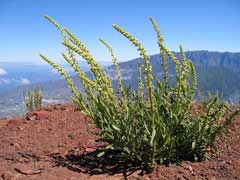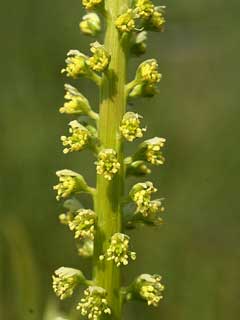 |
|
http://commons.wikimedia.org/wiki/User:Tigerente |
 |
|
Translate this page:
Summary
A common weed in North America Reseda luteola grows best in well-drained, neutral to slightly alkaline soils, in a sunny or semi-shaded position. A high-quality yellow dye is made from the seed. Mixed with the blue from woad (Isatis tinctoria) it produces greens such as Lincoln green. It has fallen into disuse with modern chemical dyes. Reseda luteola also has mild narcotic medicinal uses. Common names include dyer's rocket, dyer's weed, weld, woold, and yellow weed.
Physical Characteristics

 Reseda luteola is a BIENNIAL growing to 1.5 m (5ft) by 0.5 m (1ft 8in).
Reseda luteola is a BIENNIAL growing to 1.5 m (5ft) by 0.5 m (1ft 8in).
See above for USDA hardiness. It is hardy to UK zone 6 and is not frost tender. It is in flower from June to August, and the seeds ripen from August to September. The species is hermaphrodite (has both male and female organs) and is pollinated by Bees, insects. The plant is self-fertile.
It is noted for attracting wildlife.
Suitable for: light (sandy), medium (loamy) and heavy (clay) soils and prefers well-drained soil. Suitable pH: mildly acid, neutral and basic (mildly alkaline) soils and can grow in very alkaline soils.
It cannot grow in the shade. It prefers moist soil.
UK Hardiness Map
US Hardiness Map
Synonyms
Plant Habitats
Cultivated Beds; East Wall. In. South Wall. In. West Wall. In.
Edible Uses
Edible Parts: Oil
Edible Uses: Oil
None known
References More on Edible Uses
Medicinal Uses
Plants For A Future can not take any responsibility for any adverse effects from the use of plants. Always seek advice from a professional before using a plant medicinally.
Narcotic
Narcotic (mild).
References More on Medicinal Uses
The Bookshop: Edible Plant Books
Our Latest books on Perennial Plants For Food Forests and Permaculture Gardens in paperback or digital formats.

Edible Tropical Plants
Food Forest Plants for Hotter Conditions: 250+ Plants For Tropical Food Forests & Permaculture Gardens.
More

Edible Temperate Plants
Plants for Your Food Forest: 500 Plants for Temperate Food Forests & Permaculture Gardens.
More

More Books
PFAF have eight books available in paperback and digital formats. Browse the shop for more information.
Shop Now
Other Uses
Dye Oil
A deep yellow dye is obtained from the plant, it is of very good quality[17, 46, 74]. The plant is harvested as the last flowers fade[115]. Most of the dye is found in the seed[115]. An oil is obtained from the seed, used in lighting[100].
Special Uses
Attracts Wildlife
References More on Other Uses
Cultivation details
Easily grown in any well-drained neutral to slightly alkaline soil in a sunny position or in some shade if the summers are long and hot[200]. At one time this plant was commonly cultivated for the dye obtained from the leaves and seed but with the advent of chemical dyes it has fallen into disuse[1, 17, 46]. A good plant for bees and butterflies[200]. Plants dislike root disturbance, they can be transplanted but care must be taken not to break the tap root[169].
References Carbon Farming Information and Carbon Sequestration Information
Temperature Converter
Type a value in the Celsius field to convert the value to Fahrenheit:
Fahrenheit:
The PFAF Bookshop
Plants For A Future have a number of books available in paperback and digital form. Book titles include Edible Plants, Edible Perennials, Edible Trees,Edible Shrubs, Woodland Gardening, and Temperate Food Forest Plants. Our new book is Food Forest Plants For Hotter Conditions (Tropical and Sub-Tropical).
Shop Now
Plant Propagation
Seed - sow in situ in the spring and only just cover the seed. An autumn sowing usually succeeds in areas where winter temperatures do not fall below about -10°c[200]. The seed germinates in the autumn in the wild.
Other Names
If available other names are mentioned here
Common names include dyer's rocket, dyer's weed, weld, woold, and yellow weed.
Native Range
TEMPERATE ASIA: Afghanistan, Cyprus, Iran, Iraq, Israel, Jordan, Lebanon, Syria, Turkey, Georgia TROPICAL ASIA: Pakistan EUROPE: Czech Republic, Slovakia, Moldova, Ukraine (incl. Krym), Albania, Bulgaria, Bosnia and Herzegovina, Greece (incl. Crete), Croatia, Italy (incl. Sicily), North Macedonia, Montenegro, Serbia, Slovenia, Spain (incl. Baleares), Portugal AFRICA: Egypt, Libya, Morocco
Weed Potential
Right plant wrong place. We are currently updating this section.
Please note that a plant may be invasive in one area but may not in your area so it's worth checking.
Conservation Status
IUCN Red List of Threatened Plants Status :

Growth: S = slow M = medium F = fast. Soil: L = light (sandy) M = medium H = heavy (clay). pH: A = acid N = neutral B = basic (alkaline). Shade: F = full shade S = semi-shade N = no shade. Moisture: D = dry M = Moist We = wet Wa = water.
Now available:
Food Forest Plants for Mediterranean Conditions
350+ Perennial Plants For Mediterranean and Drier Food Forests and Permaculture Gardens.
[Paperback and eBook]
This is the third in Plants For A Future's series of plant guides for food forests tailored to
specific climate zones. Following volumes on temperate and tropical ecosystems, this book focuses
on species suited to Mediterranean conditions—regions with hot, dry summers and cool, wet winters,
often facing the added challenge of climate change.
Read More
Expert comment
Author
L.
Botanical References
17200
Links / References
For a list of references used on this page please go here
Readers comment
| Add a comment |
|
If you have important information about this plant that may help other users please add a comment or link below. Only comments or links that are felt to be directly relevant to a plant will be included. If you think a comment/link or information contained on this page is inaccurate or misleading we would welcome your feedback at [email protected]. If you have questions about a plant please use the Forum on this website as we do not have the resources to answer questions ourselves.
* Please note: the comments by website users are not necessarily those held by PFAF and may give misleading or inaccurate information.
To leave a comment please Register or login here All comments need to be approved so will not appear immediately.
|
|